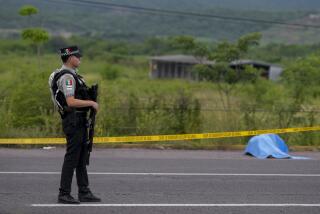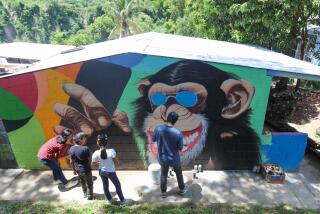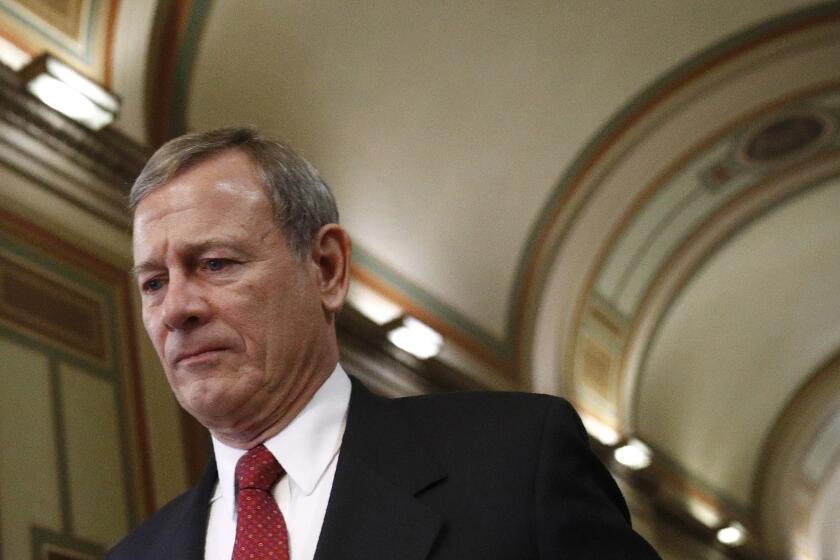COLUMN ONE : A Legacy of Conflict, Confusion : In the ‘80s, the U.S. spent billions to aid Central America. But a mixed agenda has led to mixed results--a region that is freer and more peaceful, but haunted by instability and social ills.
- Share via
SAN SALVADOR — The Salvadoran general was implicated in the 1989 murder of six Jesuit priests. He was accused of ripping off U.S. supplies for the Nicaraguan Contra guerrillas during the 1980s. During this country’s brutal civil war, he gave the orders to bomb civilian neighborhoods.
A few months ago, Gen. Juan Rafael Bustillo decided to run for president.
That a man with such a record could capture a major political party’s nomination for the presidency of El Salvador says much about the continued power and autonomy of the U.S.-built military here and throughout Central America as U.S.-backed civilian governments struggle to take charge and recover from more than a decade of war.
Throughout the ‘80s, Central America was a focal point of the administrations of Presidents Ronald Reagan and George Bush. With the stated goals of fighting Soviet-backed communism and promoting U.S.-style democracy, the U.S. government spent billions of dollars to fight some guerrillas while sponsoring others. It sought to topple some governments and prop up others.
In the process, this region was engulfed in chaos, prompting an exodus of hundreds of thousands of Central Americans to the United States.
But, ironically, the winning of one goal--building armies to fight communism--may have impeded a second: consolidating democracy.
With the end of the Cold War, Central America has been shoved far down on Washington’s agenda; it has disappeared as a concern for Moscow.
In the United States, the election of a Democratic President last year ended the Republican obsession, but not before politicians, analysts, diplomats and average citizens paused to assess the last decade.
The results, everyone agrees, are mixed.
Central America, by most reckonings, is freer and more peaceful than 10 years ago. But it is also mired deeply in poverty and struggling with the vestiges of war, from lingering hatred to headstrong militaries.
U.S.-backed civilian presidents now govern the region. But pillars of democracy--such as a functioning judicial system and basic accountability--are still missing, despite the U.S. tax dollars spent to promote them. Some of the most egregious abusers of human rights--military and civilian--will escape punishment; some may even run for public office.
Within the next seven months, open and probably fair elections will be held in four of Central America’s six Spanish-speaking countries. Yet rampant corruption--fed in part by the steady flow of U.S. dollars in the 1980s--has led to a general disgust with the political elite.
War has ended in El Salvador but threatens to burst forth again in Nicaragua. Panama is free of a dictator after an unprecedented invasion by the United States but is grappling with many of the same old problems of money laundering and drug trafficking. Honduras, which served as the rear guard for U.S. military efforts in the region, nostalgically recalls the time when U.S. cash and supplies flowed freely and now wonders where the money went, as AIDS, tuberculosis and crippling poverty spread.
Throughout Central America, children are dying of hunger, and unemployment is soaring.
“It is as though a hurricane passed through, and all that is left is the bad aftermath,” said Juan Ferrera, president of Honduras’ leading business association, as he reflected on the last decade. “The debate never was how to resolve our own conflicts, but how to resolve international conflicts.”
Many of the U.S. officials who guided policy, on the other hand, point to Central America as a success story:
“We have seen a depolarization of politics in the region, and beyond that we have seen a real change in the view of the left in many countries,” Bernard Aronson, former U.S. assistant secretary of state for Inter-American affairs in the Bush Administration, said in a recent speech. “Across Latin America, the left that wants a future in politics has now made an accommodation with free-market economics.”
The turmoil in the region can be traced in part to clashing U.S. policy goals, analysts say. Fighting communism meant building up armies that, later, when the threat diminished, resisted being brought under control and ultimately slowed democracy from taking root.
These armies are gradually being curtailed. But they remain forces largely untouchable by civilians seeking redress for past military crimes. Such impunity, politicians and human rights experts argue, is the most troubling aspect of continued military power because it undermines efforts to build a system of justice for all people, civilian and military alike.
“The issue of impunity is the core problem of Central America today,” a veteran U.S. official with extensive experience in the region said. “Central America appears to be a region with a few rules but no penalties. . . . The problem is not the military but the lack of a (strong) civil society. The civilian (leaders) ceded power for the last 30 years. They always wanted the military to fix everything. Now the military has to cede power to the civilians.”
Critics say justice will never be served in countries such as El Salvador and Nicaragua as long as there are amnesty programs that undermine attempts to hold political criminals accountable.
In El Salvador, two army officers convicted in the 1989 Jesuit priest murders walked out of prison free men a few months ago after serving barely a year of their sentences. Two guerrillas who killed a pair of injured U.S. servicemen after their helicopter was shot down were also freed recently.
Both the officers and the guerrillas were beneficiaries of a blanket amnesty pushed through by the right-wing government of President Alfredo Cristiani days after a U.N.-sponsored panel known as the Truth Commission issued a scathing report blaming most massacres, torture and other wartime atrocities on state security forces.
In Nicaragua, the government has implemented amnesty after amnesty, each time forgiving gangs of gunmen who roam the northern countryside, killing, robbing and assaulting. Critics maintain that this practice serves as encouragement for the gangs: They know that they can get away with their crimes.
In August, groups of rival gunmen kidnaped dozens of politicians--including Nicaragua’s vice president--and held them hostage for days to press various demands.
Once the gunmen released their prisoners, they were not punished but allowed to go free.
“The repeated amnesties are creating a vicious circle that must be broken,” acknowledged former Sandinista Vice President Sergio Ramirez, who until recently supported amnesty programs. “It is leading to social disintegration.”
The lack of justice may be contributing to a rash of apparently political murders in El Salvador, human rights monitors say. Two mid-level officers of the former guerrilla movement were murdered in recent weeks in circumstances that are still murky.
U.N. peacekeepers report that complaints of political murders and human rights violations increased 30% in the third quarter of the year over the previous quarter.
For many Salvadorans, the major fear is that violence will increase as elections approach. The elections--the first since the end of El Salvador’s war, last December--are scheduled for March. Voters will choose a president, 84 national legislators and scores of mayors.
“One of the central demands people are making is the demand for security,” said leftist legislator Ruben Zamora, a former head of the guerrillas’ political arm who is running for president. “Security is an indispensable (condition) for democracy. If you don’t have public safety, democracy suffers and people cannot participate or express themselves truthfully because insecurity produces fear.”
The Truth Commission accused Gen. Rene Emilio Ponce (until recently the defense minister), Gen. Bustillo and three other senior military officers of ordering the Jesuit murders, a charge they denied.
Most of the same U.S.-trained officers were also supposed to be purged from the military under terms of the U.N.-brokered peace accords that ended the war.
But Cristiani, despite strong support from Washington, bowed to pressures from the Salvadoran right and delayed the purge for six months.
To this day, according to sources, seven officers named by the Truth Commission continue on active duty.
And Bustillo, with Cristiani’s blessing, chose to run for president representing one of El Salvador’s oldest political parties. (Several months into the campaign, Bustillo withdrew his candidacy--not because of any public outcry but because he claimed that he had not been given enough power within the party.)
Today, U.S. officials argue that they actually served as a moderating force on the Salvadoran army.
As evidence, they point to neighboring Guatemala, where the military was even more brutal during its war on leftist guerrillas. Entire Indian villages were wiped out by a military that received no formal U.S. aid.
“I can say 10 years later that we should have pressured (the Salvadorans) more,” Elliott Abrams, the Reagan Administration’s point man for Central America, told reporters in San Salvador during a June visit. “It is clear we had problems with the army, because there were people in the army who thought a bloodier war would be more successful.
“They understood very well what we wanted from El Salvador--we wanted to prevent a Communist victory--and so they didn’t have to do exactly what we would have done.”
An abusive army was seen as the lesser of two evils, contrasted with Marxist guerrillas fighting to overthrow a U.S.-backed government.
Yet critics maintain that U.S. officials’ decision to turn a blind eye to abuses by the armies they were financing helped to make the military feel invulnerable and autonomous, power they remain loath to cede.
When 1987 Nobel Peace Prize winner Oscar Arias Sanchez, the former president of army-less Costa Rica, criticized the strength of the region’s armies at a recent meeting of defense ministers, he met with an angry and unified rejoinder to mind his own business.
“I think the current size of Central American armies is not justified,” said Arias, who was the moving force behind peace in the region. “It is a luxury poor countries cannot afford.”
Nicaragua has cut its army to a fraction of its wartime level, and El Salvador has slashed its military roughly in half. In Honduras, the country with perhaps the least reason for having a large army, only nominal cuts have been made.
In the 1980s, Americans poured millions of dollars into Honduras, much of it to the military.
As long as Hondurans opened their country to the Contra guerrillas and to other U.S. military ventures, no questions were asked about where the money went, U.S. officials now acknowledge. And with that kind of blind U.S. support going to the army, few Hondurans dared to challenge the military, even as it abused and spied on citizens.
Only with the end of the Cold War and the Contra war did things change.
Cresencio Arcos, the recently retired U.S. ambassador to Honduras, gave the signal, openly criticizing the military for its alleged role in a particularly brutal rape and murder.
A groundswell of opposition to military impunity soon followed.
U.S. officials watching Honduras may have realized that they had created a Frankenstein.
“What we’re doing now is damage control,” a U.S. official said. “We don’t have (the same) national security priorities. We’re not chasing red rats anymore, so we can call it what it is.”
Still, Gen. Luis Alonso Discua, who runs the army, remains enormously powerful as the military expands its ever-growing business empire to guarantee continued wealth and influence. And when candidates for next month’s Honduran presidential election began to speak of ending the draft, the army roared.
In Nicaragua, the trouble that President Violeta Barrios de Chamorro has had in reining in the mighty Sandinista army offers graphic illustration of the precarious position of a U.S.-backed, democratically elected government struggling to take charge.
For months, Chamorro had resisted mounting pressure from Washington and Nicaraguan conservatives to remove Gen. Humberto Ortega as head of the army. He came to symbolize the epitome of continued Sandinista control of Nicaragua’s security forces.
Then, using the occasion of Army Day early in September, Chamorro stunned Ortega and the rest of the top Sandinista echelon: She announced that she was dismissing the Sandinista head of intelligence and promised to replace Ortega the following year.
What happened next was unusual, even by Central American standards.
Visibly irate, Humberto Ortega and his brother, Daniel, the former president, stormed up to Chamorro after she finished her speech.
“You do not own Nicaragua,” an angry Daniel Ortega shouted at Chamorro, in the presence of three Latin American ambassadors.
“You sold out to the gringos, “ Maj. Gen. Joaquin Cuadra, the army’s No. 2 man, growled to Chamorro’s chief aide, Antonio Lacayo.
The army leadership--all Sandinistas--hastily went into an emergency session and declared that only they, and not the president, had the authority to name a new commander.
Chamorro called in her Cabinet and, after a seven-hour meeting, went on television shortly past midnight to reassert her authority before an anxious nation.
U.S. legislators have repeatedly cut off desperately needed aid to Nicaragua, demanding an end to Sandinista influence.
But Chamorro’s government maintains that freezing aid only further jeopardizes Nicaraguan democracy.
The Sandinistas, arguably Chamorro’s biggest headache, are not a problem created by the United States, although their Soviet-financed fight against a U.S. proxy army certainly supplied the pretext for building and consolidating.
What Chamorro did inherit directly from U.S. policy was the Contra army, which she disbanded upon taking office in 1990.
Many former Contras, disillusioned by the government’s failure to fulfill promises of land and assistance, as well as by the continued Sandinista influence in the government, have taken up guns again.
The so-called Re-Contras--along with rearmed former Sandinista soldiers who are equally disaffected--are wreaking havoc in rural Nicaragua, challenging Chamorro’s ability to govern.
“I came back (to Nicaragua), brought my family, thinking everything was going to get better,” former Contra commander Luis Fley said. “But everything has gone downhill. And now I have nowhere to go.”
Central America remains a heavily militarized region, thanks to both U.S. and Soviet dollars. When anti-drug police raided the sidewalk cafes in San Salvador’s tony Zona Rosa, they found little in the way of drugs--but confiscated dozens of M-16 rifles and other assorted automatic weaponry.
As much as they profess their desire to become legalized political parties, the region’s two major leftist groups--the Sandinistas of Nicaragua and El Salvador’s Farabundo Marti National Liberation Front (FMLN)--have found it difficult to relinquish their guns, their traditional instruments of power.
Despite its assurances of having disarmed, the FMLN was caught in a lie earlier this year when a secret arms dump--in Nicaragua--exploded. Another 120 caches in three countries have since been surrendered. The Managua stash, which hid fake passports and kidnaping schemes, is believed to have existed with Sandinista collusion.
“The problem for many of us is getting rid of the olive-green uniform,” said a leading Sandinista official, echoing a sentiment shared by former combatants throughout Central America. “Some stand in front of the mirror in another suit, but they don’t like what they see.”
MONDAY: Despite the billions of dollars the United States has spent, Central America remains mired in poverty and afflicted by social ills.
The U.S. Aid Pipeline
To counter a Soviet buildup, the United States poured military and economic aid into Central America in the ‘80s. Total aid for the six Spanish-speaking nations peaked in 1985, at $1.5 billion. A breakdown by nation: EL SALVADOR U.S. aid in millions of current dollars Military: $12 Other aid: $216 Current leader: Alfredo Cristiani Next elections: March, 1994 Relationship with U.S.: After years as Washington’s main Central American client state, El Salvador has seen its aid from the United States suspended or frozen twice in the last six months as a new American government openly demands military and democratic reforms. At the same time, U.S.-financed programs now benefit Salvadorans from both sides of the civil war, including Washington’s erstwhile enemies, the former Marxist guerrillas of the Farabundo Marti National Liberation Front.
*
NICARAGUA U.S. aid in millions of current dollars Other aid: $211 Current leader: Violeta Barrios de Chamorro Next elections: 1995 Relationship with U.S.: The United States favored Chamorro in her upset electoral victory over Sandinista President Daniel Ortega, but continued Sandinista influence in the government has strained Managua’s relations with Washington. The U.S. Congress recently voted to suspend aid to Nicaragua, and Clinton Administration officials are demanding Sandinista officials be removed from key security posts, developments that stymie and weaken the Chamorro government.
*
COSTA RICA U.S. aid in millions of current dollars Military: $0.2 Other aid: $23 Current leader: Rafael Angel Calderon Next elections: February, 1994 Relationship with U.S.: The oldest democracy in the region, Costa Rica looks to Washington for better economic ties. The Calderon government has clashed recently with U.S. officials over labor laws that purportedly discourage unions but is working to retain its favored trade status.
*
HONDURAS U.S. aid in millions of current dollars Military: $57 Other aid: $0.3 Current leader: Rafael Callejas Next elections: Nov. 28 Relationship with U.S.: Honduran governments were eager hosts to a vast U.S. military build-up during the 1980s dedicated to supporting Contra rebels fighting the Sandinista government in neighboring Nicaragua. Once the war was over and interests shifted, American officials began to pressure Honduran leaders on human rights and other issues, leading to tension between the two governments.
*
GUATEMALA U.S. aid in millions of current dollars Military: $0.4 Other aid: $62 Current leader: Ramiro de Leon Carpio Next elections: 1995 Relationship with U.S.: Relations between the United States and Guatemala have been thawing recently after a decade of hostility due, in part, to the abysmal record of atrocities by the Guatemalan military. Washington was especially supportive of the selection of former human rights official de Leon Carpio as president last June, following a failed coup by former President Jorge Serrano. The United States is also stepping up its drug-fighting efforts in Guatemala.
*
PANAMA U.S. aid in millions of current dollars Other aid: $14 Current leader: Guillermo Endara Next elections: May, 1994 Relationship with U.S.: Panama and the United States have had a unique, intertwined relationship for most of the century. The U.S. military installed Panama’s current government after invading and capturing dictator Manuel A. Noriega, but some American officials now question Panamanian leaders’ commitment to ending corruption and the use of Panamanian banks as money-laundering centers for Colombian drug-traffickers.
SOURCE: Congressional Research Service
A Decade of Turmoil
March 24, 1980. Archbishop Oscar Romero is assassinated by a right-wing death squad, pushing El Salvador closer to civil war.
January, 1981. Ronald Reagan assumes the presidency of the United States, making the war on communism the center of policy toward Central America. Within months, American officials secretly begin organizing Nicaraguan Contras, step up aid and training for the Salvadoran military and set up military installations in Honduras.
March, 1984. In El Salvador, U.S.-backed candidate Jose Napoleon Duarte, a Christian Democrat, is elected president by defeating reputed death squad organizer Roberto D’Aubuisson.
Oct. 5, 1986. Secret Contra supply plane is shot down over Nicaragua, exposing the U.S. government’s covert network and eventually revealing the Iran-Contra affair, the biggest scandal to hit the Reagan presidency.
March 19, 1989. Alfredo Cristiani, a moderate leader of the right-wing Nationalist Republican Alliance (ARENA), is elected president of El Salvador.
November, 1989. Salvadoran guerrillas launch largest offensive of the war, seizing parts of the capital for the first time.
Nov. 16, 1989. At the height of the offensive, an army platoon murders six Jesuit priests, their cook and her 15-year-old daughter, dragging them from the beds where they slept.
Dec. 19, 1989. The United States invades Panama in pursuit of Gen. Manuel Antonio Noriega, who has been indicted on drug charges. Hundreds of people, mostly Panamanians, are killed. Noriega surrenders days later.
Feb. 26, 1990. In Nicarauga, Violeta Barrios de Chamorro leads a broad, conservative coalition to victory over Sandinista leader Daniel Ortega in presidential elections.
May, 1990. Contra rebels agree to disband.
April 4, 1991. Salvadoran government and guerrillas begin talks that will lead to a landmark peace agreement by the end of the year.
More to Read
Sign up for Essential California
The most important California stories and recommendations in your inbox every morning.
You may occasionally receive promotional content from the Los Angeles Times.











